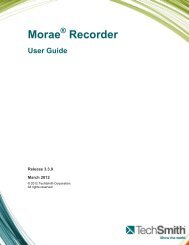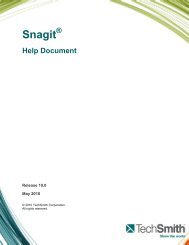Get Great Audio Camtasia Studio - TechSmith
Get Great Audio Camtasia Studio - TechSmith
Get Great Audio Camtasia Studio - TechSmith
Create successful ePaper yourself
Turn your PDF publications into a flip-book with our unique Google optimized e-Paper software.
A Look at Different Kinds of Microphones<br />
Choosing the correct microphone for your recording needs can be a time consuming process. Certain types of<br />
microphones produce good recordings in some environments while produce poor recordings in others. It is important<br />
to select the correct microphone to meet your recording needs.<br />
General Microphone Tips<br />
The most expensive microphone will not necessarily produce better quality recordings. It is important to select the<br />
right microphone to complement your hardware and recording situational needs.<br />
Choose a microphone with lower output impedance. For acceptable results, the output impedance of the microphone<br />
must be less than the input impedance of the sound card, which is in the range of 600-1500. Look for a microphone<br />
with output impedance of about 1000 ohms.<br />
A Word about Pickup Patterns<br />
The microphone pickup pattern determines from which direction the microphone picks up the sound the best.<br />
Microphones can be designed to be sensitive to sounds from given directions, while they reject sounds from others.<br />
The directional characteristics, or pickup pattern of a microphone, are defined by noting the direction from which a<br />
microphone is optimally sensitive to sound waves.<br />
Microphones can only pick up the sound waves which strike it. This means that proper placement of the microphone<br />
is critical to good sound. For example, a pickup pattern can be selected for its ability to reject unwanted sound coming<br />
from a particular direction and to help reduce feedback. A microphone pickup pattern should be based on the<br />
application. For example, most lavaliere microphones are omnidirectional, so that no matter which way the speaker’s<br />
head turns, it will pick up their voice.<br />
Omnidirectional Microphones<br />
Omnidirectional microphones pick up sound equally from all directions with a slight preference for sounds coming<br />
from the direction in which they are pointed. Omnidirectional microphones are typically used for recording with group<br />
pick-up. The level and sound quality will be identical whether you speak from the front or the back of the microphone.<br />
Omnidirectional microphones are:<br />
1. Effective for recording a meeting or panel discussion where all speakers are near each other.<br />
2. Not well-suited for noisy environments.<br />
Cardioid (Unidirectional) Microphones<br />
Cardioid microphones have a heart-shaped pickup pattern and are sensitive to sounds predominantly from the front of<br />
the microphone diaphragm. They pickup sounds which come from the direction in which they are pointed and reject<br />
sound coming from the sides and the rear. The ability to reject unwanted sounds is the primary reason cardioid<br />
microphones are the most-used for presentations and recording.<br />
14
















